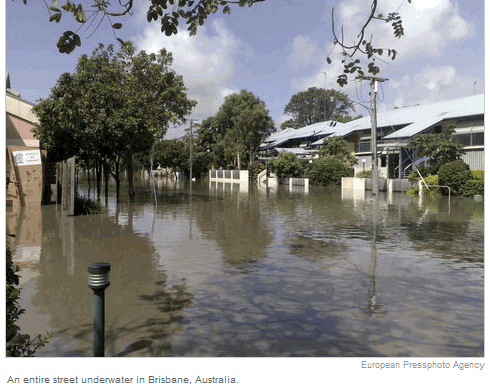|
|
|
|
|
|
|
News & Views item - January 2011 |
![]() Has Global Warming Exacerbated the Queensland Floods? (January 13, 2011)
Has Global Warming Exacerbated the Queensland Floods? (January 13, 2011)
While it may be tempting for those contending that global warming has had a hand in exacerbating the current crisis of extensive flooding devastating Queensland, just what data can be brought to bear to support the contention.
Matthew England of the Climate Change Research Centre at the University of New South Wales told Reuters: "I think people will end up concluding that at least some of the intensity of the monsoon in Queensland can be attributed to climate change. The waters off Australia are the warmest ever measured and those waters provide moisture to the atmosphere for the Queensland and northern Australia monsoon."

David Jones, head of climate monitoring and prediction at the Australia Bureau of Meteorology put is this way: "We've always had El Ninos and we've had natural variability but the background which is now operating is different. The first thing we can say with La Nina and El Nino is it is now happening in a hotter world; so the El Nino droughts would be expected to be exacerbated and also La Nina floods because rainfall would be exacerbated."
In short, more evaporation from land and oceans, more moisture in the atmosphere -- stronger weather patterns. But he agreed that it would be some years before firm conclusions could be reached as to the extent of the effect.
Kevin Trenberth, head of the Climate Analysis Section at the US National Center for Atmospheric Research noting the high ocean temperatures in the Indian Ocean near Indonesia in early 2010 as well as the rapid onset of La Nina after the subsidence of El Nino in May said: "The rapid onset of La Nina meant the Asian monsoon was enhanced and the over 1OC anomalies in sea surface temperatures led to the flooding in India and China in July and Pakistan in August." Furthermore, in his view the 0.5OC, of the ocean temperatures around northern Australia, which are more than 1.5OC above pre-1970 levels, could be attributed to global warming.
He went on to explain: "The extra water vapour fuels the monsoon and thus alters the winds and the monsoon itself and so this likely increases the rainfall further; so it is easy to argue that 1OC sea surface temperature anomalies gives 10 to 15 percent increase in rainfall."
Nevertheless, Neville Nicholls of Monash University in Melbourne and president of the Australian Meteorological and Oceanographic Society cautions: "It's a natural phenomena. We have no strong reason at the moment for saying this La Nina is any stronger than it would be even without humans," but agreed that 0.75OC of global atmospheric warming over the past half century had to be having some impact. "It has to be affecting the climate, regionally and globally. It has to be affecting things like La Nina. But can you find a credible argument which says it's made it worse? I can't at the moment."